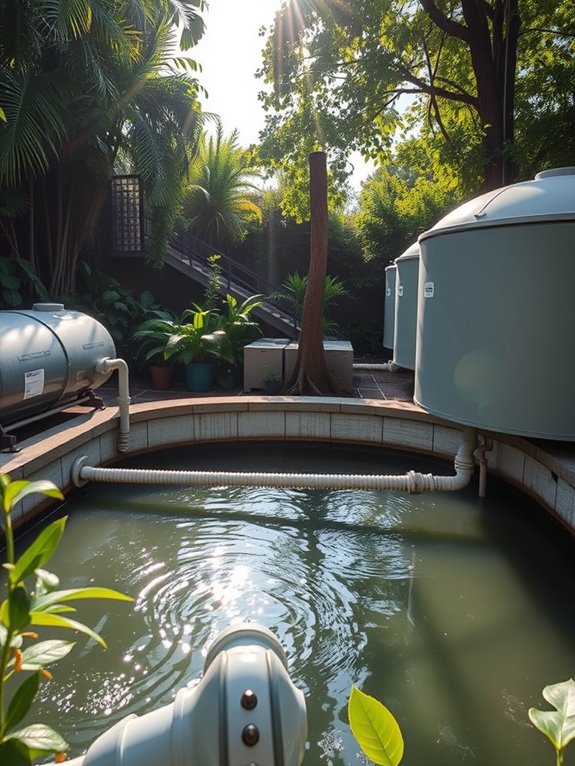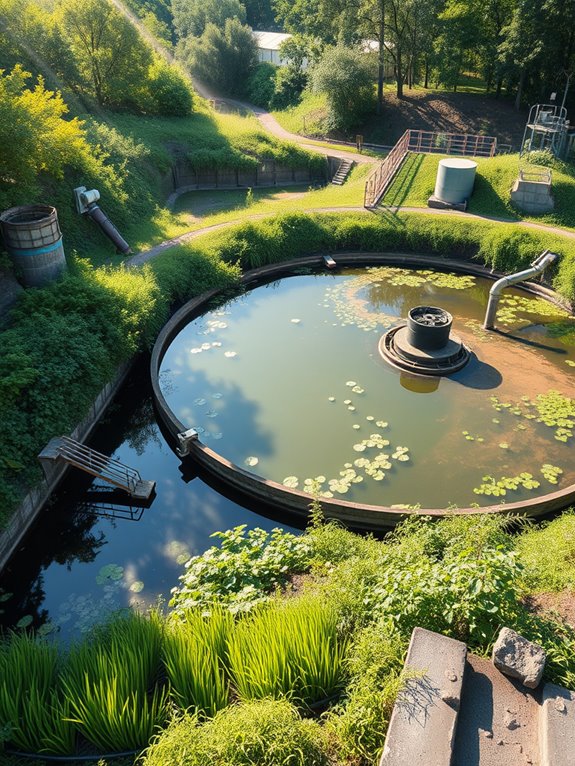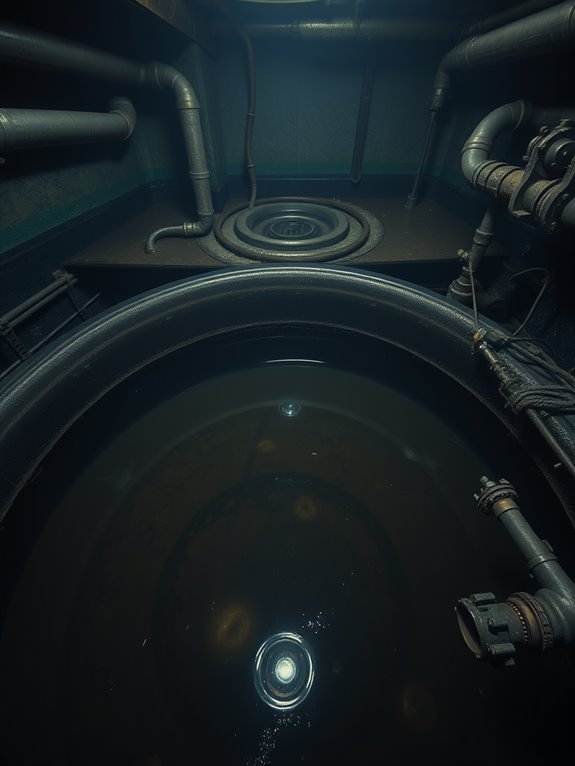Anaerobic water treatment systems use microorganisms to treat wastewater without oxygen, offering you benefits like reduced sludge production and biogas generation. The process includes hydrolysis, acidogenesis, and methanogenesis, effectively breaking down organic materials. These systems can handle diverse wastewater types, especially from industries like food processing and agriculture. By utilizing this method, you can support sustainable practices and enhance resource recovery. There's much more about how these systems work and their future applications to discover.
Overview of Anaerobic Water Treatment Systems

When you consider sustainable waste management, anaerobic water treatment systems stand out as an efficient solution.
These systems treat wastewater without oxygen, relying on microorganisms to break down organic material. By creating a sealed environment, they prevent methane emissions and allow for biogas production, which can be harnessed for energy.
They're particularly effective for high-strength wastewater, like that from food processing industries.
You'll find various designs, such as anaerobic digesters and upflow anaerobic sludge blanket (UASB) reactors, each catering to specific needs.
Ultimately, these systems not only reduce waste but also contribute to a circular economy by recovering valuable resources.
Key Benefits of Anaerobic Treatment
Anaerobic treatment offers several key benefits that make it an attractive option for wastewater management.
First, it markedly reduces sludge production, lowering disposal costs and environmental impact.
You'll also appreciate its energy efficiency; this process generates biogas, which can be harnessed for energy, helping to offset operational expenses.
Additionally, anaerobic systems require less space than aerobic alternatives, making them suitable for locations with limited land availability.
They're also effective at breaking down organic materials, making them ideal for treating high-strength wastewater.
The Anaerobic Treatment Process Explained

Understanding the anaerobic treatment process is essential for grasping how it effectively manages wastewater. This process harnesses microorganisms to break down organic matter in the absence of oxygen, resulting in biogas and treated effluent. The key stages include hydrolysis, acidogenesis, and methanogenesis.
| Stage | Key Activity | Byproducts |
|---|---|---|
| Hydrolysis | Breakdown of complex matter | Fatty acids |
| Acidogenesis | Conversion to acids | Hydrogen, CO2 |
| Methanogenesis | Production of methane | Biogas |
This method not only reduces waste volume but also generates renewable energy!
Types of Anaerobic Water Treatment Systems
Now that you understand the anaerobic treatment process, let's explore the different types of anaerobic water treatment systems.
You'll find fixed film systems and upflow anaerobic sludge blankets among the most common options.
Each system has its unique features and benefits that can suit various treatment needs.
Fixed Film Systems
While exploring various anaerobic water treatment systems, you'll find that fixed film systems play an essential role in efficiently treating wastewater. These systems utilize a solid surface for microbial growth, allowing biofilms to develop and degrade organic matter. They require less space compared to traditional systems and optimize treatment efficiency.
| Feature | Description |
|---|---|
| Surface Area | Provides ample space for biofilm growth |
| Hydraulic Retention | Enhances contact time for treatment |
| Maintenance | Generally lower due to fixed media |
Incorporating fixed film systems can greatly improve your wastewater management strategy.
Upflow Anaerobic Sludge Blanket
Building on the efficiency of fixed film systems, Upflow Anaerobic Sludge Blanket (UASB) systems offer another innovative approach to anaerobic water treatment.
In UASB systems, wastewater flows upward through a blanket of granular sludge, promoting effective biogas production and solid separation.
You'll find they're particularly beneficial for treating high-strength organic waste, thanks to their compact design and minimal energy requirements.
As you implement UASB technology, you'll appreciate its ability to reduce sludge production and lower operational costs.
Applications of Anaerobic Water Treatment

Anaerobic water treatment systems are increasingly being utilized across various sectors due to their efficiency in managing organic waste.
You'll find these systems in industries like food processing, agriculture, and wastewater treatment, where they effectively break down high-strength organic materials.
They're also popular in biogas production, converting waste into renewable energy.
Municipalities often adopt these systems to reduce sludge volume and enhance overall treatment efficiency.
Furthermore, anaerobic treatment is valuable for treating landfill leachate, helping to mitigate environmental impacts.
Comparison With Aerobic Treatment Systems
When comparing anaerobic and aerobic treatment systems, it's vital to understand their fundamental differences in processing organic waste.
Anaerobic systems thrive without oxygen, relying on microorganisms to break down waste, producing biogas as a byproduct. In contrast, aerobic systems require oxygen, using aerobic bacteria for decomposition, which typically leads to faster processing times.
Anaerobic systems often generate less sludge, while aerobic systems can be more efficient in nutrient removal.
Your choice between the two depends on factors like energy efficiency, space availability, and treatment goals, making it important to evaluate your specific needs before deciding which system suits you best.
Challenges and Limitations of Anaerobic Systems

While anaerobic systems offer unique advantages, they also come with their own set of challenges and limitations. You might encounter issues like slower reaction rates, which can affect efficiency.
These systems can be sensitive to fluctuations in temperature and pH, making them less reliable under varying conditions. Additionally, the buildup of volatile fatty acids can lead to system instability.
You'll also need to guarantee proper mixing to avoid sedimentation. Finally, odor management can be a concern, requiring effective control measures.
Understanding these limitations will help you make informed decisions when considering anaerobic systems for water treatment.
Future Trends in Anaerobic Water Treatment Technology
As you look ahead, innovative treatment technologies are transforming anaerobic water treatment systems.
You'll notice a focus on enhancing biogas production and integrating systems for improved efficiency.
These trends promise to make anaerobic processes even more effective and sustainable.
Innovative Treatment Technologies
With the increasing emphasis on sustainability and resource recovery, innovative treatment technologies in anaerobic water treatment are rapidly evolving to meet modern challenges.
You'll find that advancements like membrane bioreactors and integrated fixed-film activated sludge systems enhance efficiency and performance. These technologies allow for better separation of solids and liquids, improving treatment outcomes.
Additionally, real-time monitoring systems are becoming essential, providing data that helps optimize processes. By implementing these innovations, you can reduce energy consumption and improve overall system resilience.
Staying informed about these trends will empower you to make more sustainable choices in water treatment practices.
Enhanced Biogas Production
Enhanced biogas production is transforming the landscape of anaerobic water treatment technology.
You'll find that recent advancements are boosting the efficiency of biogas generation from organic waste. By optimizing microbial activity and employing advanced reactor designs, you can harness more energy from the same amount of feedstock.
This not only enhances energy recovery but also reduces greenhouse gas emissions. As you explore these innovations, you'll discover the potential for integrating waste-to-energy solutions, making your water treatment systems more sustainable.
Ultimately, enhanced biogas production can lead to significant cost savings and contribute to a circular economy.
Embrace these changes for better outcomes!
Integrated Systems Approaches
The evolution of anaerobic water treatment technology is increasingly leaning towards integrated systems approaches that combine various treatment processes for improved efficiency and sustainability.
You'll find these systems often merge anaerobic digestion with advanced oxidation processes or membrane technologies, enhancing pollutant removal while maximizing biogas production.
This holistic approach not only optimizes resource use but also minimizes waste generation.
By integrating multiple technologies, you can achieve greater flexibility in handling diverse wastewater types.
As regulations tighten, adopting these integrated systems will become essential for achieving compliance and promoting environmental stewardship in wastewater management.
Embracing this trend positions you for future success.
Conclusion
To sum up, anaerobic water treatment systems offer a sustainable solution for managing wastewater while producing valuable biogas. Did you know that these systems can reduce sludge production by up to 90% compared to conventional aerobic methods? This not only minimizes waste but also lowers operational costs. As these technologies continue to evolve, they promise even greater efficiency and environmental benefits, making them an attractive option for industries looking to enhance their sustainability efforts.

I’m Allen Kim, the chief editor of plumbinginto. I am a mid level plumber and assign to an local firm over 4 years of experience. During the working period, most of my experience is related to the house plumbing. I learned about the thing, when working with most experienced people in this sector, one must be as good as the inspector or better with knowledge of the project as well as the practical aspects of plumbing industry.